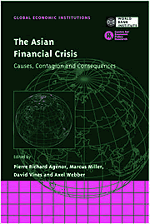Book contents
- Frontmatter
- Contents
- List of figures
- List of tables
- Preface
- List of conference participants
- Acknowledgements
- List of abbreviations and acronyms
- Introduction
- Part One General Accounts
- Part Two Theoretical Contributions
- 5 Capital markets and the instability of open economies
- Discussion
- 6 Volatility and the welfare costs of financial market integration
- Discussion
- 7 A theory of the onset of currency attacks
- Discussion
- Part Three Contagion
- Part Four Policy Responses
- Index
Discussion
from Part Two - Theoretical Contributions
Published online by Cambridge University Press: 26 February 2010
- Frontmatter
- Contents
- List of figures
- List of tables
- Preface
- List of conference participants
- Acknowledgements
- List of abbreviations and acronyms
- Introduction
- Part One General Accounts
- Part Two Theoretical Contributions
- 5 Capital markets and the instability of open economies
- Discussion
- 6 Volatility and the welfare costs of financial market integration
- Discussion
- 7 A theory of the onset of currency attacks
- Discussion
- Part Three Contagion
- Part Four Policy Responses
- Index
Summary
Chapter 7 takes further the ideas of Morris and Shin (1998) in that it allows for more natural Brownian-motion representation of fundamentals. In addition the chapter assumes that the information of market participants about the true value of the fundamental is distributed according to a normal distribution about the true value, as opposed to a uniform distribution in the earlier paper. This allows the authors to tell a dynamic story about when a currency attack might occur, and also to examine what happens when the nature of the differential private information is varied. The results remain startling: a tiny departure from common knowledge entirely eliminates the multiplicity of equilibria. This work represents a major challenge to the traditional multiple-equilibrium models of currency attacks, most notably associated with Obstfeld (1986, for example). Of course the insights here are also applicable to other market situations with similar multiple-equilibrium properties, such as bank-run models.
The arguments of the chapter, however, are technical and it is difficult to get a clear idea of why a small departure from common knowledge about the fundamental can lead to such a radical change in the set of equilibria. So I will start by attempting an overview of the argument, before discussing the extent to which I think these insights are important.
- Type
- Chapter
- Information
- The Asian Financial CrisisCauses, Contagion and Consequences, pp. 256 - 262Publisher: Cambridge University PressPrint publication year: 1999



